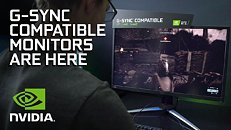Monday, November 25th 2019

NVIDIA to Open G-Sync Monitors to VRR Support, Enabling AMD Graphics Cards Support
In the wars of variable refresh rates, much ink has already been spilled regarding the open, AMD FreeSync approach and NVIDIA's proprietary G-Sync modules. The war started to give its first signs of abatement once NVIDIA seemed to throw in the towel by officially supporting VESA's VRR (Variable Refresh Rate) technology on its graphics cards, basically opening the way for NVIDIA graphics cards to correctly operate with previously AMD FreeSync-branded monitors. Now, it seems one more step will be taken on that road which should be G-Sync's proprietary approach final whiff, since according to a report from TFT Central, confirmed by NVIDIA, the company will enable VRR support for next releases of monitors equipped with the company's G-Sync module. This will essentially enable AMD graphics cards to work with NVIDIA-branded G-Sync monitors.This move will only work for future monitor releases, mind you - a firmware update which will be distributed amongst monitor makers will enable the next releases of G-Sync to support VESA's VRR standard. This will not, apparently, be happening with already-released G-Sync modules, whether carrying NVIDIA's first take on the technology, nor the v2 G-Sync modules. It's not a perfect solution, and current adapters of G-Sync are still locked-in to NVIDIA graphics cards for VRR support on their monitors. It is, however, a definite step forward. Or a step backwards from a proprietary, apparently unneeded technology - you can really look at it either way.Whether or not this makes sense from a product standpoint will only be understood once pricing on future NVIDIA G-Sync monitors surfaces - but we are finding it a hard sell for monitor makers to invest much in the G-Sync module going forward, since there are no practical, user-observable differences aside final product cost.
Source:
TFT Central



66 Comments on NVIDIA to Open G-Sync Monitors to VRR Support, Enabling AMD Graphics Cards Support
This may be a sad day, because, as hated as it was, G-Sync did one thing right: it imposed refresh limits on manufacturers. FreeSync doesn't and the logo can be awarded to monitors that do VRR over a 1Hz range as a result. Before you ask, I don't know of a monitor with such a narrow range, but monitors with unusable ranges are everywhere.
Then again, who knows, once everybody backs FreeSync, maybe FreeSync3 or 4 will eventually enforce some ranges, like G-Sync does.
(Yes, I know I used "FreeSync a little liberally, I am too lazy to keep writing VRR/AdaptiveSync.)
AMD had nothing to do with this other than having an open standard. NVIDIA could've sat on gsyncs ecosystem a lot longer. It probably was profit that drove them not to do so, yes, but accrediting this move (which involves new gsync module firmware at minimum) to AMD in any way is an absurd thought excercise.
People seem to think I have some side in this. They seem to forget I had an exclusively Ryzen/AMD system but a year ago, and love AMD as much as is healthy. That's not an excuse to bring them up where irrelevant, or worship them as anything more than what they are: A profit driven company.
Gsync modules do offer some advantages, but they are so small the panel should matter exponentially more.